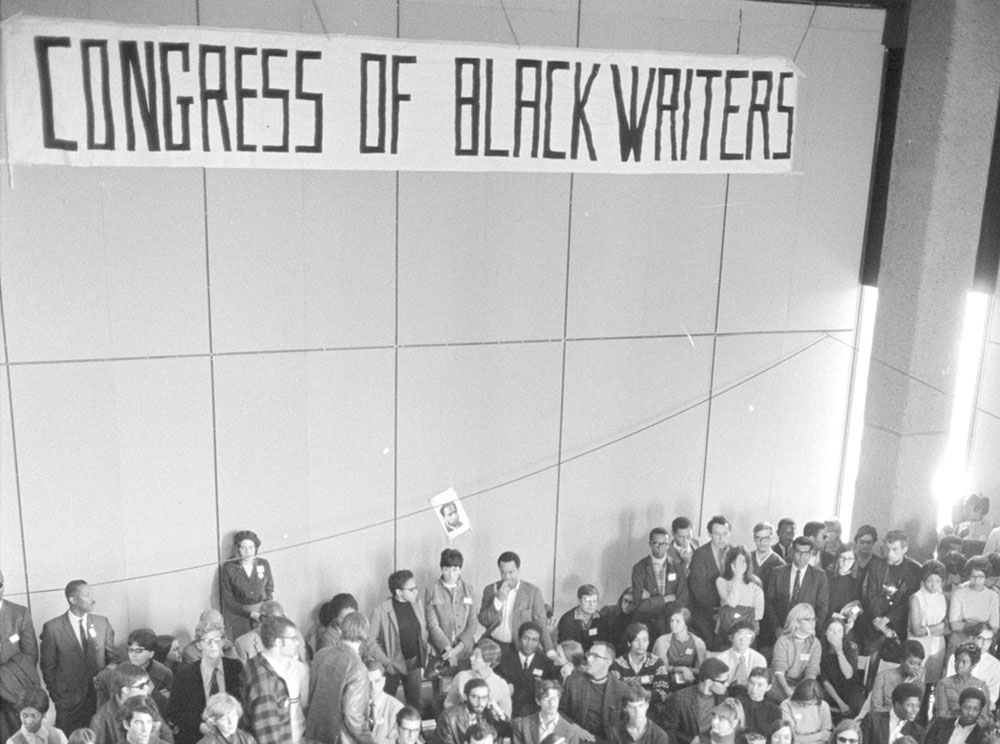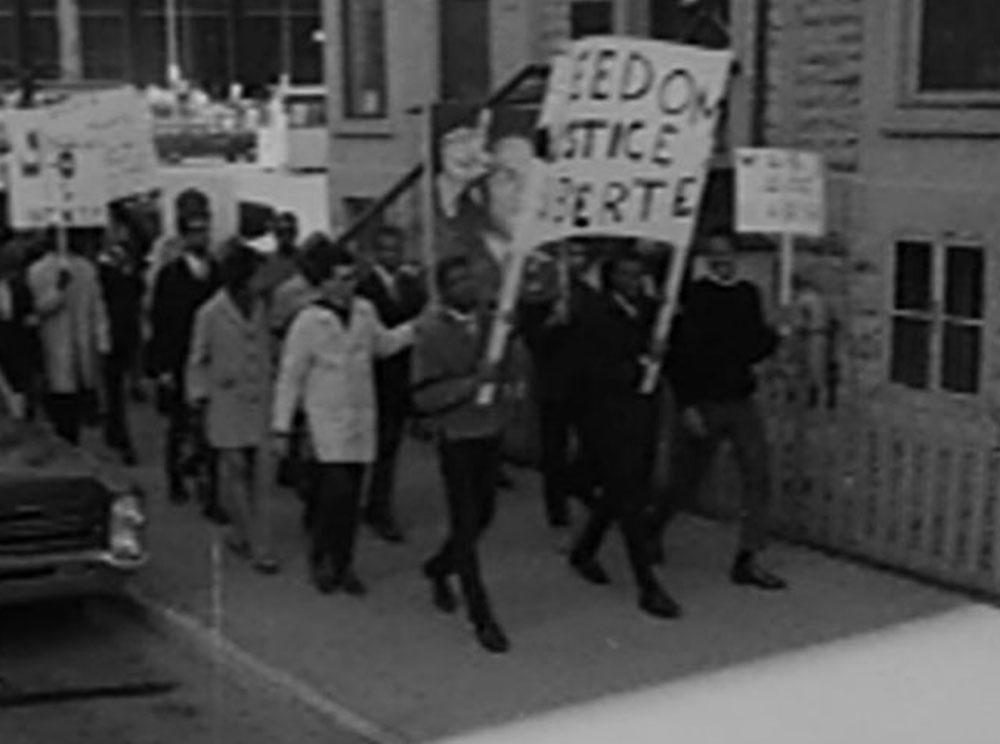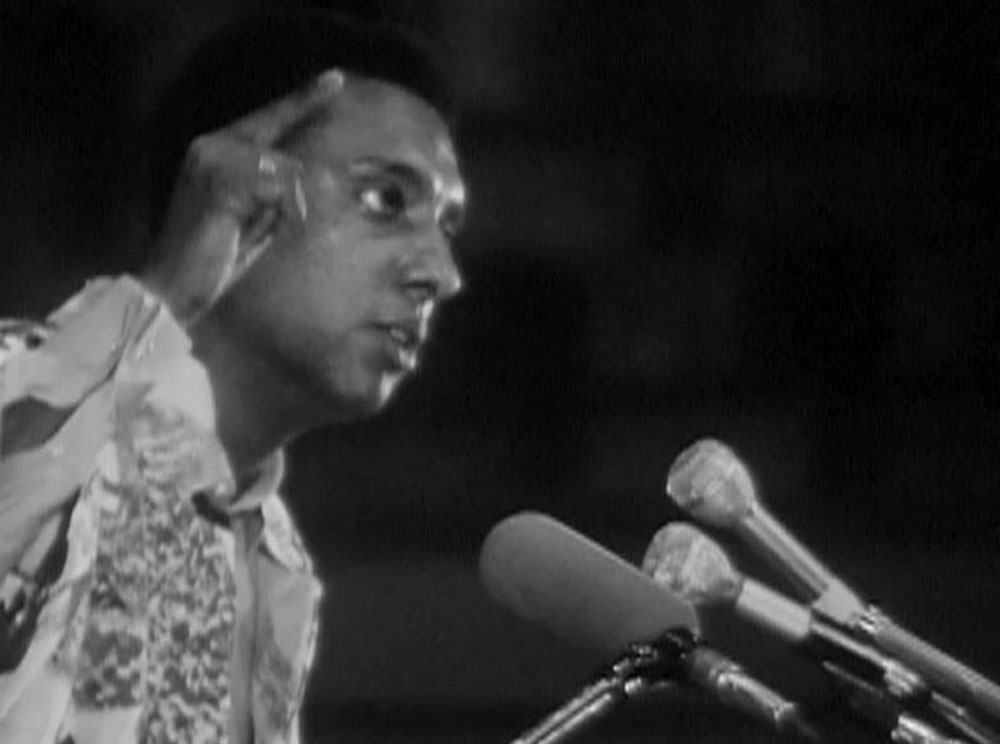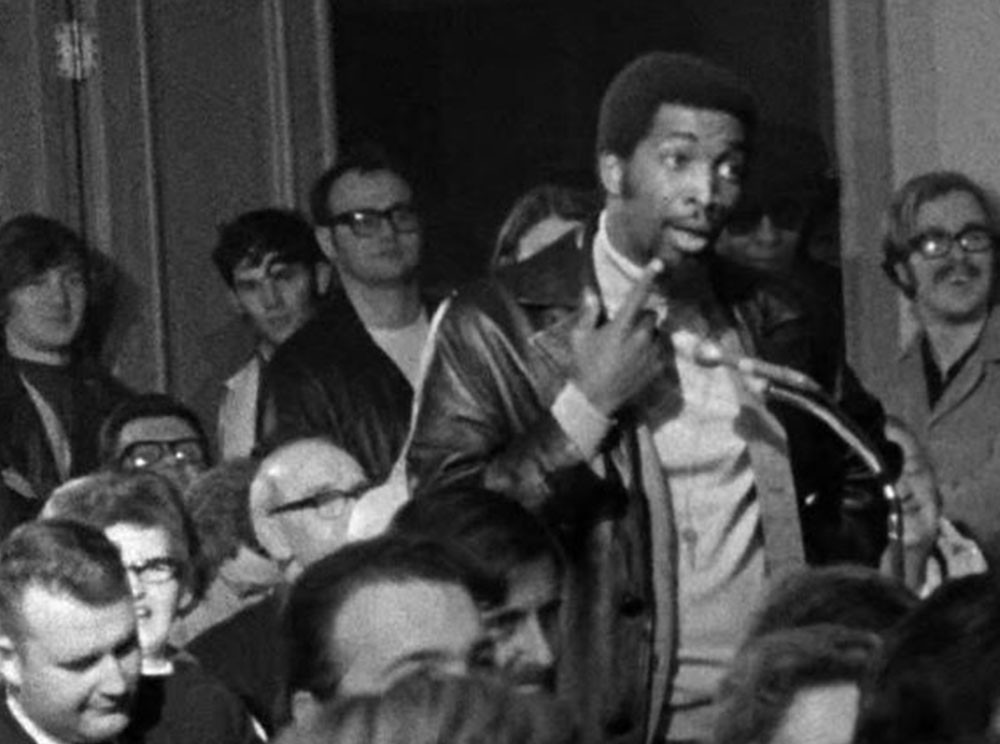
Martin Luther King Jr. at a press conference
Photograph
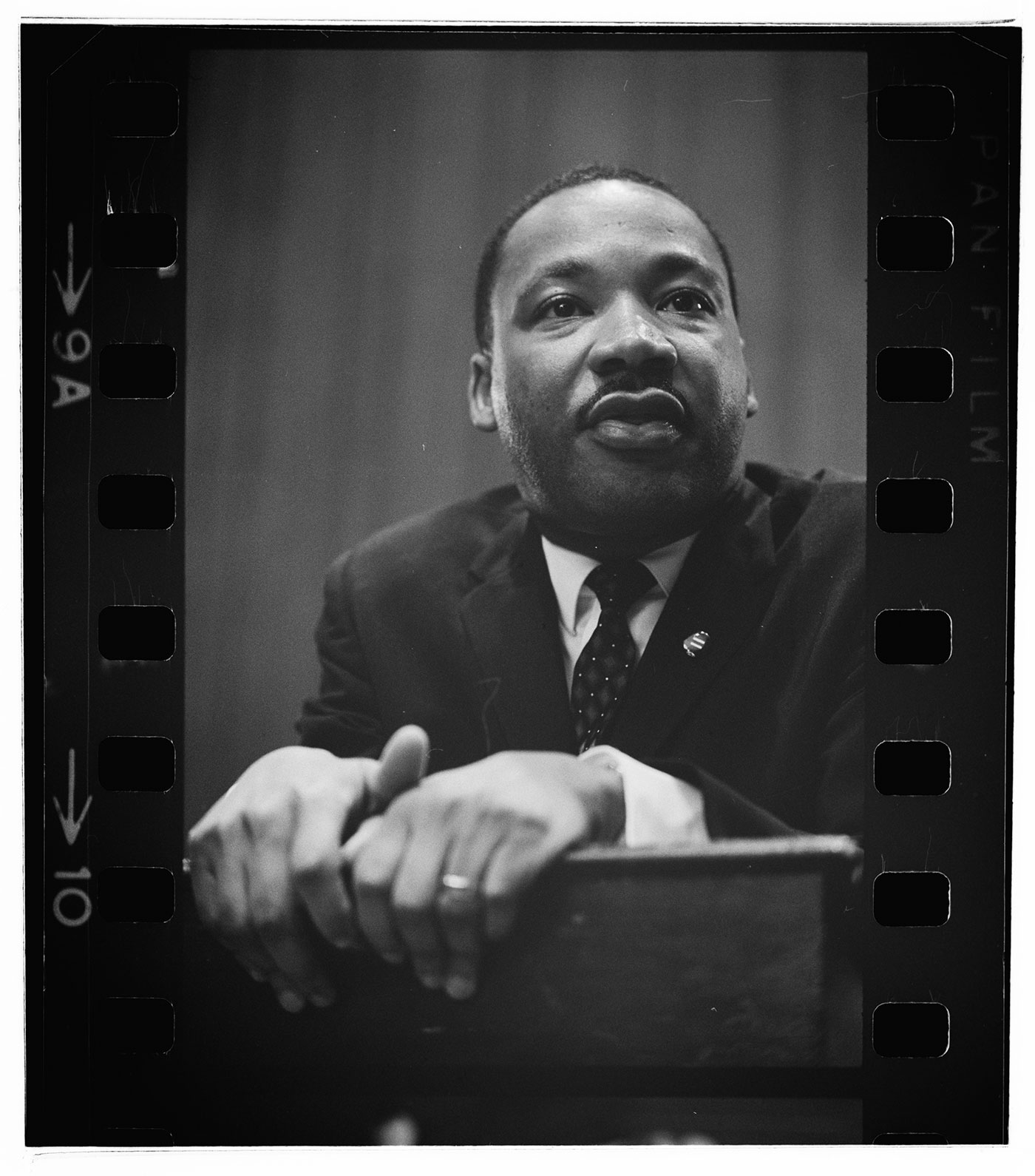

Image
Video
Audio
 Activities
Activities
LOOK
Examine the photo of Dr. Martin Luther King Jr. Why do you think his involvement in the civil rights movement was important to him? How old does he look in the photo? How old was he when he died?
THINK
Watch and listen to the CBC announcement of his death. What is the tone of the announcer? What feelings come to mind when you hear this? What was your first thought?
DO
Using the Internet, research the names of Dr. King’s wife and his children. How old were they when he died? Think about a time you lost a loved one or someone close to you. How did you feel?
Details
 Materials
Materials - Photograph
Historical Context
Choose one of the three levels below to match your needs.
- Photo of Dr. Martin Luther King Jr., and video excerpt of a CBC broadcaster announcing King’s death.
- Dr. King was a leader of the civil rights movement, which began in the 1950s and continued through the 1970s.
- The movement advocated for social justice and the human rights of all people regardless of race or colour.
- Marches, protests, freedom rides, and sit-ins were held globally to bring attention to the harsh and brutal treatment that denied a segment of society equal rights.
- King’s murder was a shock to the world.
- King was 39 years old when he was murdered, and left behind his wife, Coretta, and four young children.
- The Congress of Black Writers at McGill University in Montréal was organized to honour King’s legacy and the legacies of other civil rights leaders who were murdered.
- Scroll through the media carousel to see the video excerpt of the CBC broadcast announcing King’s death.
This is a photo of Dr. Martin Luther King Jr., and a video excerpt from the CBC broadcast announcing his assassination on April 4, 1968.
Dr. King was a leader of the civil rights movement, which began in the 1950s and continued throughout the 1970s.
The civil rights movement was a campaign that fought for social justice for people of African descent and others who were disenfranchised. It arose as a result of the brutal and harsh treatment encountered by a nation of people due to their ethnic origin.
Marches, protests, freedom rides, and sit-ins were held to bring attention to the unjust treatment that denied segments of society their basic human rights.
The announcement of Dr. King’s death on the CBC and other news outlets was a shock to the world. He was 39 years old when he was murdered, and he left behind his wife, Coretta, and four young children.
The Congress of Black Writers at McGill University in Montréal took place six months later to honour King’s legacy and the legacies of other civil rights leaders who were murdered.
Scroll through the media carousel to see the video excerpt of the CBC broadcast announcing King’s death.
This is a photo of Dr. Martin Luther King Jr., and a video excerpt from the CBC broadcast announcing his assassination on April 4, 1968.
Dr. King was a leader of the civil rights movement, which began in the 1950s and continued throughout the 1970s. Dr. King spent his short life advocating for social justice and the rights of people of African descent and those disenfranchised by societal norms.
The civil rights movement began because of the brutal and harsh treatment encountered by a nation of people due to their ethnic origin. Marches, protests, freedom rides, and sit-ins were held throughout the United States and Canada to bring attention to the unjust treatment that denied people their basic human rights. Segregation and discrimination were deemed acceptable by those in power.
The announcement of King’s death on the CBC and other news outlets was a shock to the world, especially to those who believed in social justice for all people. Dr. King was 39 years old and left behind his wife, Coretta, and four young children.
The Congress of Black Writers at McGill University, which took place six months after King’s murder, was organized and planned to honour his legacy and the legacies of other civil rights leaders who were murdered.
Scroll through the media carousel to see the video excerpt of the CBC broadcast announcing King’s death.
- Photo of Dr. Martin Luther King Jr., and video excerpt of a CBC broadcaster announcing King’s death.
- Dr. King was a leader of the civil rights movement, which began in the 1950s and continued through the 1970s.
- The movement advocated for social justice and the human rights of all people regardless of race or colour.
- Marches, protests, freedom rides, and sit-ins were held globally to bring attention to the harsh and brutal treatment that denied a segment of society equal rights.
- King’s murder was a shock to the world.
- King was 39 years old when he was murdered, and left behind his wife, Coretta, and four young children.
- The Congress of Black Writers at McGill University in Montréal was organized to honour King’s legacy and the legacies of other civil rights leaders who were murdered.
- Scroll through the media carousel to see the video excerpt of the CBC broadcast announcing King’s death.
This is a photo of Dr. Martin Luther King Jr., and a video excerpt from the CBC broadcast announcing his assassination on April 4, 1968.
Dr. King was a leader of the civil rights movement, which began in the 1950s and continued throughout the 1970s.
The civil rights movement was a campaign that fought for social justice for people of African descent and others who were disenfranchised. It arose as a result of the brutal and harsh treatment encountered by a nation of people due to their ethnic origin.
Marches, protests, freedom rides, and sit-ins were held to bring attention to the unjust treatment that denied segments of society their basic human rights.
The announcement of Dr. King’s death on the CBC and other news outlets was a shock to the world. He was 39 years old when he was murdered, and he left behind his wife, Coretta, and four young children.
The Congress of Black Writers at McGill University in Montréal took place six months later to honour King’s legacy and the legacies of other civil rights leaders who were murdered.
Scroll through the media carousel to see the video excerpt of the CBC broadcast announcing King’s death.
This is a photo of Dr. Martin Luther King Jr., and a video excerpt from the CBC broadcast announcing his assassination on April 4, 1968.
Dr. King was a leader of the civil rights movement, which began in the 1950s and continued throughout the 1970s. Dr. King spent his short life advocating for social justice and the rights of people of African descent and those disenfranchised by societal norms.
The civil rights movement began because of the brutal and harsh treatment encountered by a nation of people due to their ethnic origin. Marches, protests, freedom rides, and sit-ins were held throughout the United States and Canada to bring attention to the unjust treatment that denied people their basic human rights. Segregation and discrimination were deemed acceptable by those in power.
The announcement of King’s death on the CBC and other news outlets was a shock to the world, especially to those who believed in social justice for all people. Dr. King was 39 years old and left behind his wife, Coretta, and four young children.
The Congress of Black Writers at McGill University, which took place six months after King’s murder, was organized and planned to honour his legacy and the legacies of other civil rights leaders who were murdered.
Scroll through the media carousel to see the video excerpt of the CBC broadcast announcing King’s death.
Summary
- Photo of Dr. Martin Luther King Jr., and video excerpt of a CBC broadcaster announcing King’s death.
- Dr. King was a leader of the civil rights movement, which began in the 1950s and continued through the 1970s.
- The movement advocated for social justice and the human rights of all people regardless of race or colour.
- Marches, protests, freedom rides, and sit-ins were held globally to bring attention to the harsh and brutal treatment that denied a segment of society equal rights.
- King’s murder was a shock to the world.
- King was 39 years old when he was murdered, and left behind his wife, Coretta, and four young children.
- The Congress of Black Writers at McGill University in Montréal was organized to honour King’s legacy and the legacies of other civil rights leaders who were murdered.
- Scroll through the media carousel to see the video excerpt of the CBC broadcast announcing King’s death.
Essential
This is a photo of Dr. Martin Luther King Jr., and a video excerpt from the CBC broadcast announcing his assassination on April 4, 1968.
Dr. King was a leader of the civil rights movement, which began in the 1950s and continued throughout the 1970s.
The civil rights movement was a campaign that fought for social justice for people of African descent and others who were disenfranchised. It arose as a result of the brutal and harsh treatment encountered by a nation of people due to their ethnic origin.
Marches, protests, freedom rides, and sit-ins were held to bring attention to the unjust treatment that denied segments of society their basic human rights.
The announcement of Dr. King’s death on the CBC and other news outlets was a shock to the world. He was 39 years old when he was murdered, and he left behind his wife, Coretta, and four young children.
The Congress of Black Writers at McGill University in Montréal took place six months later to honour King’s legacy and the legacies of other civil rights leaders who were murdered.
Scroll through the media carousel to see the video excerpt of the CBC broadcast announcing King’s death.
In-Depth
This is a photo of Dr. Martin Luther King Jr., and a video excerpt from the CBC broadcast announcing his assassination on April 4, 1968.
Dr. King was a leader of the civil rights movement, which began in the 1950s and continued throughout the 1970s. Dr. King spent his short life advocating for social justice and the rights of people of African descent and those disenfranchised by societal norms.
The civil rights movement began because of the brutal and harsh treatment encountered by a nation of people due to their ethnic origin. Marches, protests, freedom rides, and sit-ins were held throughout the United States and Canada to bring attention to the unjust treatment that denied people their basic human rights. Segregation and discrimination were deemed acceptable by those in power.
The announcement of King’s death on the CBC and other news outlets was a shock to the world, especially to those who believed in social justice for all people. Dr. King was 39 years old and left behind his wife, Coretta, and four young children.
The Congress of Black Writers at McGill University, which took place six months after King’s murder, was organized and planned to honour his legacy and the legacies of other civil rights leaders who were murdered.
Scroll through the media carousel to see the video excerpt of the CBC broadcast announcing King’s death.

